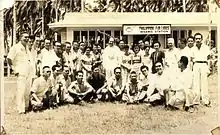Labo Airport
Labo Airport (Cebuano: Tugpahanan sa Labo) (IATA: OZC, ICAO: RPMO), also known as Ozamiz Airport, is an airport serving the general area of the city of Ozamiz in the Philippines. It is the only airport in the province of Misamis Occidental. The airport is classified as a community airport by the Civil Aviation Authority of the Philippines, a body of the Department of Transportation that is responsible for the operations of not only this airport but also of all other airports in the Philippines except the major international airports. It is one of only two community airports in the Philippines with commercial operations, but one of the busiest in Mindanao in terms of aircraft movement and passenger traffic.
Labo Airport Tugpahanan sa Labo | |||||||||||
|---|---|---|---|---|---|---|---|---|---|---|---|
 Exterior of Labo Airport | |||||||||||
| Summary | |||||||||||
| Airport type | Public | ||||||||||
| Operator | Civil Aviation Authority of the Philippines | ||||||||||
| Serves | Ozamiz | ||||||||||
| Location | Labo, Ozamiz | ||||||||||
| Elevation AMSL | 5 m / 16 ft | ||||||||||
| Coordinates | 08°10′42.69″N 123°50′28.99″E | ||||||||||
| Website | ozamizairport | ||||||||||
| Map | |||||||||||
.svg.png.webp) OZC Location of airport in Philippines | |||||||||||
| Runways | |||||||||||
| |||||||||||
| Statistics (2017) | |||||||||||
| |||||||||||
Source: Statistics from eFOI[1] | |||||||||||
The airport takes its name from its location, barangay Labo in Ozamiz City.
Ozamiz Airport also serves the cities of Oroquieta and Tangub, some municipalities of Zamboanga del Sur, Lanao del Norte and some parts of Lanao del Sur.
History

It was known as Misamis Airfield during the Pre-World War II and Post-World War II until the municipality become a cityhood status in 1948 and was change of what is now Ozamiz Airport. Philippine Airlines, the first airline to operate the airport, serves regular air service to this airport using the McDonnell Douglas DC-3 from Manila. In 80's-90's, Philippine Airlines was using their Fokker 50 and Sunriser planes to Manila and Cebu until the closure of the airport.
The airport was closed in 1998 after Philippine Airlines (PAL) stopped the operation of their smaller Fokker and Sunriser planes because its runway could not accommodate jetliners and wide-bodied aircraft. PAL was affected by financial crisis and labor disputes during that period.
On July 11, 2007, Ozamiz Airport was re-opened[2] to the public with the former President Gloria Macapagal Arroyo and the Provincial and City Officials joined the ceremonial event. PAL subsidiary PAL Express (then known as Air Philippines) was the first airline to land using Boeing 737-200 also the first jet plane to land during the opening of the airport.[3] With the opening of the airport, this would expect the increase of passenger volume due to its strategically located and boost the economy and tourism of Ozamiz, Misamis Occidental and neighboring towns and provinces.
On November 10, 2008, Cebu Pacific Air launched its Ozamiz-Cebu[4] & v.v. using the brand-new ATR 72-500. With the entrance of Cebu Pacific Air in Ozamiz, this would give to the passengers to be easily access and more choices to choose from Cebu. PAL Express became the competitor of Cebu Pacific Air to/from Cebu.
On June 16, 2009, after the expansion and widening of the runway and passed the runway jet requirement, the Airbus A319 successfully smooth landed at the airport by Cebu Pacific Air in the morning[5] and the comeback Philippine Airlines at noon.[6] That day was the memorable event of the airport that officially, it is now capable for Airbus A320 family jet.
On March 25, 2012, Philippine Airlines transferred their Ozamiz routes as PR163 and PR164 to PAL Express (known at that times as Airphil Express). Last Summer 2012, Ozamiz Airport officially known as an Airbus Airport since Cebu Pacific Air and Airphil Express are both using Airbus A319 and Airbus A320 to and from Manila and Cebu. That was also the time when Cebu Pacific Air added its 2nd flight to/from Manila in the late afternoon flight until July 2012.
Currently, Ozamiz-Labo Airport is serving Manila and Cebu routes using A320, A319, Q400 and ATR 72-500 by Philippine Airlines operated by PAL Express (former Airphil Express) and Cebu Pacific Air daily.
Rehabilitation and expansion
Extension and expansion of the airport runway started in 2005 using congressional funds of Misamis Occidental District 2 Congresswoman Herminia Ramiro. It was reopened to commercial flights on July 8, 2007, with Air Philippines offering direct Ozamiz-Manila v.v. routes. The airport is expected to have a bigger budget from the national government in the coming months because of its strategic location, increasing volume of passengers and cargoes.
Expansion and development of the airport particularly its runway, tarmac and passenger terminal building continued again in the 1st quarter of 2008. Come July 2009, implementation of the asphalt overlay will begin for the entire 1.9 kilometer runway, apron and taxiway. This includes the setting up of runway lights to accommodate night flight operations.
Civil Aviation Authority of the Philippines(CAAP) announced that 14 provincial airports in the Philippines will have to install night capable landing so that the airplanes can land safely at night and to ease the congestion problem of Ninoy Aquino International Airport, the main airport in the Philippines. Ozamiz Airport[7] is included in the project. Soon, Ozamiz Airport will capable for night landing flights.
On November 29, 2018, President Rodrigo Duterte led the groundbreaking ceremony of the new passenger terminal as part of the modernization project of the airport. The entire cost of the project is about P922 million.[8] It is also part of the Build Build Build program of the administration.[9][10]
Airlines and destinations

| Airlines | Destinations |
|---|---|
| Cebu Pacific | Manila |
| Cebu Pacific operated by Cebgo | Cebu |
| Philippine Airlines operated by PAL Express | Cebu,[11] Manila |
Statistics
| Year | Passenger Movement |
Percentage Increase and Country Rank |
|---|---|---|
| 2007 | 20,618 | |
| 2008 | 80,290 | |
| 2009 | 161,048 | |
| 2010 | 206,428 | |
| 2011 | 228,956 | |
| 2012 | 272,850 | |
| 2013 | 424,216 | |
| 2014 | 224,253 | |
| 2015 | 218,985 | |
| 2016 | 290,996 | |
| 2017 | 294,661[12] | |
| 2018 | 333,891 | |
| 2019 | 371,945 |
| Year | Cargo Movement | Percentage Increase |
|---|---|---|
| 2016 | 5,437,415 | |
| 2015 | 4,143,110 | |
| 2014 | 3,925,413 | |
| 2013 | 4,563,663 | |
| 2012 | 3,697,311 | |
| 2011 | 3,330,270 | |
| 2017 | ||
| 2018 | 5,822,719 | |
| 2019 | 5,998,308 |
| Year | Aircraft Movement | Percentage Increase |
|---|---|---|
| 2016 | 2,314 | |
| 2015 | 2,018 | |
| 2014 | 2,080 | |
| 2013 | 2,870 | |
| 2012 | 2,574 | |
| 2011 | 2,606 | |
| 2017 | ||
| 2018 | 3,217 | |
| 2019 | 3,596 |
References
- Civil Aviation Authority of the Philippines (23 July 2018). "Yearly Passenger, Cargo and Aircraft Movements of all airports in the Philippines 1997-2017". Republic of the Philippines - Freedom of Information Portal. Retrieved 13 August 2018.
- "PIA daily news in English, Tagalog, Cebuano, Hiligaynon, Ilocano, Waray, Pangalatok from around the Philippines". Archives.pia.gov.ph.
- "The Exciting Centennial of Philippine Aviation: RPMO heats up as airlines battle for air supremacy". Philippineairspace.blogspot.com. Retrieved 1 September 2019.
- "Archived copy". Archived from the original on 2013-04-10. Retrieved 2013-03-09.CS1 maint: archived copy as title (link)
- "Oops! Looks like the site is currently undergoing maintenance". Philippineairlines.com.
- "Archived copy". Archived from the original on 2016-03-04. Retrieved 2013-03-09.CS1 maint: archived copy as title (link)
- Dominguez-Cargullo, Dona (November 29, 2018). "Modernisasyon ng Ozamiz Airport, uumpisahan na". Philippine Daily Inquirer. Radyo Inquirer. Retrieved 1 December 2018.
- "President Duterte led the groundbreaking of Ozamiz Airport Modernization Project". Philippine News Agency. November 30, 2018. Retrieved 1 December 2018.
- "Night Rating of Ozamis Airport". Build.gov.ph. Retrieved 1 December 2018.
- "Flight Timetable". Philippineairlines.com.
- "eFOI - Electronic Freedom of Information - Request". Foi.gov.ph. Retrieved 2018-05-18.
External links
| Wikimedia Commons has media related to Ozamiz Airport. |